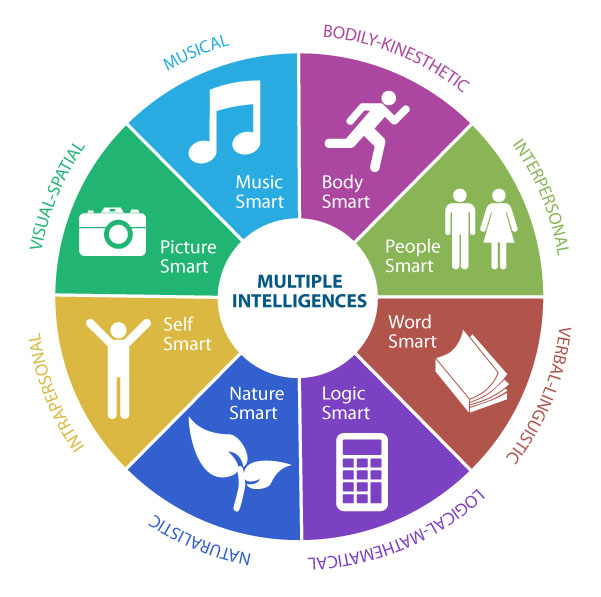Chapter 2 Learning Preferences
2.1 Learning Preferences and Strengths
What Are Your Learning Preferences?

Different people have different learning preferences. There are many models which are used to describe these preferences. Learning styles is one that accounts for learner differences, which can be useful in understanding the different ways we learn. It can also be useful to know your strengths and use them to enhance learning.
Style refers to a student’s specific learning preferences and actions. One student may learn more effectively from listening to the instructor, while another prefers to take notes. Another learns more effectively from reading the textbook, while another student benefits most from charts, graphs, and images the instructor presents during a lecture. It’s important to note that people don’t necessarily have a single style. Students can use different styles in different situations, but they often tend toward specific preferences.
Learning style is important in college and university. Each different style, described later in more detail, has certain advantages and disadvantages compared with other styles. None is “right” or “wrong.” You can learn to use different styles more effectively.
Instructors also have different teaching styles, which may or may not match up well with your learning preference. Although you may personally prefer a certain style of teaching, you cannot expect that your instructors will use exactly the style that you prefer. Therefore it is important to know how to adapt to teaching styles.
It is important to note that there are many criticisms of the learning styles model. Some researchers purport that there is no evidence that identifying a learner’s learning style and then teaching to it accordingly results in increased student outcomes. Another criticism is that identifying one single learning style or method of learning and focusing on it alone can result in ignoring the other learning modalities, and this could ultimately hamper learning. It is much more useful to think of it like this: if you recognize a learning strength, then use that strength by adding more of it to your learning strategies. But don’t stop using the other modalities. For example, if you discover that listening is a strength for you, then it would be useful for you to add listening activities to your coursework, such as downloading lectures and re-listening to them while you are doing other activities (riding the bus, going for a run, or doing the dishes). But listening to lectures on your phone should not replace attending classes, practising concepts by doing homework questions, or working together in study groups – as these are all things that can enhance your learning as well.
Consider the following theories and see if any of the concepts resonate with you.
Multiple Intelligences
Often, we associate learning in university with strengths in reading and writing. Though it is true that reading and writing are important skills used in many courses, you can also apply other learning strengths to contribute to successful learning.
Different systems have been used to describe the different ways in which people learn. Some describe the differences between how extroverts (outgoing, gregarious, social people) and introverts (quiet, private, contemplative people) learn. Some divide people into “thinkers” and “feelers.”
A popular framework is Multiple Intelligences, based on research by Howard Gardner. Gardner proposed that there are eight different ways of learning, creating things, and solving problems. Everyone uses all eight of these intelligences; however, in each individual, some intelligences are areas of strength, while others are weaker, leading to different preferences in learning. The eight multiple intelligences are:
- Verbal (prefers words)
- Logical (prefers math and logical problem solving)
- Visual (prefers images and spatial relationships)
- Kinesthetic (prefers body movements and doing)
- Rhythmic (prefers music, rhymes)
- Interpersonal (prefers group work)
- Intrapersonal (prefers introspection and independence)
- Naturalist (prefers nature, natural categories)

Here is a more detailed description of the different intelligences:
| Intelligence | Description |
|---|---|
| “Word smart” Verbal-Linguistic Intelligence | The capacity to use language to express what’s on your mind and to understand other people. People who are high in this intelligence are sensitive to language, meanings, and the relationship of words. They engage easily with vocabulary activities, grammar, poetry, essays and plays. |
| “Logic smart” Logical-Mathematical Intelligence | People with a highly developed logical-mathematical intelligence understand the underlying principles of some kind of a causal system; or can manipulate numbers, quantities, and operations. Abstract thinking, counting, organizing; and logical structures are preferred by people high in this intelligence. They also like critical thinking activities, breaking words into smaller parts and reassembling them. |
| “Picture smart” Visual-Spatial Intelligence | People strong in this intelligence have the ability to represent the spatial world internally in their minds. Spatial intelligence can be used in the arts or in the trades and sciences. Those who are spatially intelligent and oriented toward the arts, are more likely to become painters or sculptors or architects than, say, musicians or writers. These people tend to be keen observers, able to think in three dimensions, and like to use metaphors. Learning materials that work well for them include: graphs, charts, colour codes, guided imagery, pictures, posters, and mind maps. |
| “Body smart” Bodily-Kinesthetic Intelligence | Body smart people have the capacity to use their whole body or parts of their body –hands, fingers, arms – to solve a problem, make something, or put on some kind of a production. These people have good body control and fine motor skills; and are often active and animated. They need “hands-on” learning opportunities, like shop, labs, games, skits, and plays. |
| “Music smart” Musical Intelligence | Music smart people have the capacity to think in music, to be able to hear patterns, recognize them, remember them, and perhaps manipulate them. People who have a strong musical intelligence don’t just remember music easily – they can’t get it out of their minds, it’s so omnipresent. People will be sensitive to rhythm, pitch, intonation, and can remember tunes and rhythms easily. They tend to like poems, plays, jazz chants, rap music, songs, and musically guided imagery. |
| “People smart” Interpersonal Intelligence | Those who are people smart have an understanding of other people. Anybody who deals with people has to be skilled in the interpersonal sphere. This is a social intelligence and those who are high in this area are outgoing and interactive; sensitive to others’ moods, feelings, and motivations. |
| “Self smart” Intrapersonal Intelligence | Self smart people have an understanding of themselves, of knowing who they are, what they can do, what they want to do, how they react to things, which things to avoid, and which things to gravitate toward. They tend to know what they can do. They tend to know what they can’t do, and they also tend to know where to go if they need help. |
| “Nature smart” Naturalistic Intelligence | Nature smart people have the ability to discriminate among living things (plants, animals), sensitivity to other features of the natural world (clouds, rock configurations) as well as a good sense of their surroundings and environment. They are also sensitive to changes around them, both outdoors and indoors. |
| Gardner later added a 9th intelligence: “Life Smart” Existential Intelligence
|
People with existential intelligence have the sensitivity and capacity to tackle deep questions about human existence, such as the meaning of life, the reason for death, and the explanation of how we got here. They tend to be reflective, deep-thinking, and able to design abstract theories. They appreciate multiple perspectives, see connections, challenge assumptions, and push boundaries. They can become scientists, philosophers, and theologians. |
It is also important to note that we can continue to develop our intelligence, and use multiple intelligences to learn content in any course. Our brains continue to grow and develop over time, even into adulthood. Taking full advantage of these opportunities for growth can support learning in any course.
Exercise: Multiple Intelligences
Go to Howard GardnerL Multiple Intelligences Test and scroll down to the link for “free Multiple Intelligences test (based on Howard Gardner’s model)—in Microsoft Excel self-calculating format, and other versions.” You need Microsoft Excel on your computer to take this free online assessment of your preferred multiple intelligences learning styles.
Clicking the link will download an Excel spreadsheet with 74 questions. Answer each as directed on the 1 to 4 scale. Your score totals are then shown for each of the “multiple intelligences” learning styles.
OR
Use this assessment to discover your intelligence strengths:
Multiple Intelligences Self-Assessment Quiz
- What are your two strongest “intelligence types?”
- What are your two weakest “intelligence types?”
- Based on this evaluation, what aspects of learning might you want to give more attention to?
The multiple intelligences approach recognizes that different people have different ways, or combinations of ways, of relating to the world. Here is an example of visual-spatial intelligence, as an artistic, autistic savant draws the New York City skyline from memory.
Video: “Stephen Wiltshire draws NYC for UBS” (length 3:49)
VARK Learning Styles

A popular approach to learning styles is called the VARK approach [1], which focuses on learning through different senses (Visual, Aural, Reading/Writing, and Kinesthetic):
- Visual learners prefer images, charts, and the like.
- Aural learners learn better by listening.
- Reading/writing learners learn better through written language.
- Kinesthetic learners learn through doing, practising, and acting.
You can take a free, self-scored online assessment of your VARK learning style at VARK Learning Styles Questionnaire [PDF].
Once you discover the differences in learning styles and how they pertain to you, it may help you to shed light on your own learning habits and preferences, and give you ideas for incorporating other strategies. You shouldn’t conclude that you are one type of learner or another and that you should just focus your learning on using your preferred learning style as previously thought. It can be hard to break study habits which have formed over many years. However, by incorporating different modalities in your learning, you are more likely to remember and understand. Think of it as having a toolbox of ways to think and learn, and for each task, ask yourself which tool is the best one for the job.
There are many systems used by educators to describe the various ways in which people learn. These systems can help you learn more about how you as an individual person and post-secondary student learn – both in your current study strategies and in how you could enhance your learning by including other less familiar strategies. Feel free to research this further on your own.
Exercise: VARK Learning Styles
- My preferred learning styles from the VARK model are:
- I will begin working to strengthen my learning through these other styles:
Cultural Preferences
Some learning preferences are determined by culture and practice. Certain cultures or groups have specific ways of learning that differ from traditional Western practices. Indigenous learning, for example, often uses story-telling to demonstrate concepts. Stories are passed down from generation to generation, using elders to teach the younger ones. Learning in this manner incorporates social aspects, feelings of safety, and a familiarity for Indigenous learners.

Exercise: Cultural or Group Learning Preferences
Think about whether there are certain styles of learning, whether it be because of your culture, race, religion, association, or other group, that has influenced your style of learning. What practices are familiar to you? What practices help you learn better?
Learning preferences come in many forms. Whatever learning model you consider, you should pay attention to what works for you (and what doesn’t) and organize your study sessions accordingly.
Text Attributions
- Text under the “What Are Your Learning Preferences” and “VARK Learning Styles” headings is from “How You Learn” in University Success by N. Mahoney, B. Klassen, and M. D’Eon. Adapted by Mary Shier. CC BY-NC-SA.
- Text under the “Multiple Intelligences” heading is from “Evaluate Your Learning Skills and Strengths” in University 101 by Kwantlen Polytechnic University. CC BY-SA. Adapted by Mary Shier. CC BY.
Video Attributions
- Stephen Wiltshire draws NYC for UBS by 4heraldsq. Standard YouTube licence.
Media Attributions
- Multiple Intelligences © Sajaganesandip is licensed under a CC BY-SA (Attribution ShareAlike) license
- Learning Circle © Gordon Shier is licensed under a CC BY (Attribution) license
- Fleming, N.D. (1996). Teaching and Learning Styles: VARK Strategies. Hershey, PA: IGI Global. ↵

